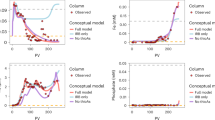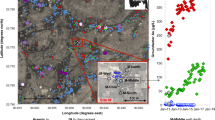Abstract
Arsenic contamination of groundwater continues to threaten the health of millions of people in southeast Asia. The oxidation of organic carbon, coupled to the reductive dissolution of arsenic-bearing iron oxides, is thought to control the release of sediment-bound arsenic into groundwater. However, the cause of the high spatial variability in groundwater arsenic concentrations—which can range from 5 to 500 μg l−1 within distances of a few kilometres—has been uncertain. Here, we combine measurements of sediment age, organic-matter reactivity and water chemistry at four locations along a cross-section of the arsenic-contaminated Red River floodplain in Vietnam to determine the origin of variations in groundwater arsenic concentrations. The burial age of the aquifer sediments, determined using optical stimulated luminescence, ranged from 460 years near the course of the present-day river to 5,900 years at the margin of the floodplain. The groundwater arsenic content and the reactivity of sedimentary organic carbon, determined using radiotracer measurements of the rate of methanogenesis, declined with sediment age. The sedimentary pools of both iron and arsenic also declined with the burial age of the sediments. We suggest that the age of aquifer sediments is a key determinant of groundwater arsenic concentrations.
This is a preview of subscription content, access via your institution
Access options
Subscribe to this journal
Receive 12 print issues and online access
$259.00 per year
only $21.58 per issue
Buy this article
- Purchase on Springer Link
- Instant access to full article PDF
Prices may be subject to local taxes which are calculated during checkout




Similar content being viewed by others
References
Winkel, L. et al. Arsenic pollution of groundwater in Vietnam exacerbated by deep aquifer exploitation for more than a century. Proc. Natl Acad. Sci. USA 108, 1246–1251 (2011).
Van Geen, A. et al. Spatial variability of arsenic in 6000 tube wells in a 25 km2 area of Bangladesh. Wat. Resour. Res. 39, 1140 (2003).
BGS/DPHE (British Geological Survey, Dept. Public Health Engineering). Arsenic Contamination of Groundwater in Bangladesh, Final Report (British Geological Survey, 2001).
Fendorf, S., Michael, H. A. & van Geen, A. Spatial and temporal variations of groundwater arsenic in south and southeast Asia. Science 328, 1123–1127 (2010).
Ravenscroft, P., Brammer, H. & Richards, K. Arsenic Pollution: A Global Synthesis (Wiley-Blackwell, 2009).
McArthur, J. M., Ravenscroft, P., Safiulla, S. & Thirlwall, M. F. Arsenic in groundwater: Testing pollution mechanisms for sedimentary aquifers in Bangladesh. Wat. Resour. Res. 37, 109–117 (2001).
Dowling, C. B., Poreda, R. J., Basu, A. R., Peters, S. L. & Aggarwal, P. K. Geochemical study of arsenic release mechanisms in the Bengal Basin groundwater. Wat. Resour. Res. 38, 1173–1190 (2002).
Harvey, C. F. et al. Arsenic mobility and groundwater extraction in Bangladesh. Science 298, 1602–1606 (2002).
Swartz, C. H. et al. Mobility of arsenic in a Bangladesh aquifer: Inferences from geochemical profiles, leaching data, and mineralogical characterization. Geochim. Cosmochim. Acta 68, 4539–4557 (2004).
Postma, D. et al. Arsenic in groundwater of the Red River floodplain, Vietnam: Controlling geochemical processes and reactive transport modeling. Geochim. Cosmochim. Acta 71, 5054–5071 (2007).
Postma, D. et al. Mobilization of arsenic and iron from Red River floodplain sediments, Vietnam. Geochim. Cosmochim. Acta 74, 3367–3381 (2010).
Neumann, R. B. et al. Anthropogenic influences on groundwater arsenic concentrations in Bangladesh. Nature Geosci. 3, 46–52 (2010).
Rowland, H. A. L. et al. The control of organic matter on microbially mediated iron reduction and arsenic release in shallow alluvial aquifers. Geobiology 5, 281–292 (2007).
Berg, M. et al. Hydrological and sedimentary controls leading to arsenic contamination of groundwater in the Hanoi area, Vietnam: The impact of iron-arsenic ratios, peat, river bank deposits, and excessive groundwater abstraction. Chem. Geol. 249, 91–112 (2008).
Islam, F. S. et al. Role of metal-reducing bacteria in arsenic release from Bengal delta sediments. Nature 430, 68–71 (2004).
Van Geen, A. et al. Decoupling of As and Fe release to Bangladesh groundwater under reducing conditions. Part II: Evidence from sediment incubations. Geochim. Cosmochim. Acta 68, 3475–3486 (2004).
Radloff, K. A. et al. Mobilization of arsenic during one-year incubations of grey aquifer sands from Araihazar, Bangladesh. Environ. Sci. Technol. 41, 3639–3645 (2007).
Murray, A. S. & Wintle, A. G. Luminescence dating of quartz using an improved single-aliquot regenerative-dose protocol. Radiat. Measurements 32, 57–73 (2000).
Murray, A. S. & Wintle, A. G. The single aliquot regeneration dose protocol: Potential for improvements in reliability. Radiat. Measurements 37, 377–381 (2003).
Larsen, F. et al. Controlling geological and hydrogeological processes in an arsenic contaminated aquifer on the Red River flood plain, Vietnam. Appl. Geochem. 23, 3099–3115 (2008).
Appelo, C. A. J. & Postma, D. Geochemistry, Groundwater and Pollution 2nd edn (Balkema Publ., 2005).
Jakobsen, R. & Postma, D. Redox zoning, rates of sulfate reduction and interactions with Fe-reduction and methanogenesis in a shallow sandy aquifer, Rømø, Denmark. Geochim. Cosmochim. Acta 63, 137–151 (1999).
Hansen, L. K., Jakobsen, R. & Postma, D. Methanogenesis in a shallow sandy aquifer, Rømø, Denmark. Geochim. Cosmochim. Acta 65, 2925–2935 (2001).
Postma, D. & Jakobsen, R. Redox zonation: Equilibrium constraints on the Fe(III)/SO4-reduction interface. Geochim. Cosmochim. Acta 60, 3169–3175 (1996).
Conrad, R. Contribution of hydrogen to methane production and control of hydrogen concentrations in methanogenic soils and sediments. FEMS Microbiol. Ecol. 28, 193–202 (1999).
Jakobsen, R. & Cold, L. Geochemistry at the sulphate reduction-methanogenesis transition zone in an anoxic aquifer—a partial equilibrium interpretation using 2D reactive transport modeling. Geochim. Cosmochim. Acta 71, 1949–1966 (2007).
Polizzotto, M. L., Kocar, B. D., Benner, S. B., Sampson, M. & Fendorf, S. Near-surface wetland sediments as a source of arsenic release to ground water in Asia. Nature 454, 505–508 (2008).
Thamdrup, B. Bacterial manganese and iron reduction in aquatic sediments. Adv. Microb. Ecol. 16, 41–84 (2000).
Larsen, O., Postma, D. & Jakobsen, R. The reactivity of iron oxides towards reductive dissolution with ascorbic acid in a shallow sandy aquifer (Rømø, Denmark). Geochim. Cosmochim. Acta 70, 4827–4835 (2006).
Postma, D. The reactivity of iron oxides in sediments: A kinetic approach. Geochim. Cosmochim. Acta 57, 5027–5034 (1993).
Larsen, O. & Postma, D. Kinetics of bulk dissolution of lepidocrocite, ferrihydrite and goethite. Geochim. Cosmochim. Acta 65, 1367–1379 (2001).
Wenzel, W. W. et al. Arsenic fractionation in soils using an improved sequential extraction procedure. Anal. Chim. Acta 436, 309–323 (2001).
Banwart, S., Davies, S. & Stumm, W. The role of oxalate in accelerating the reductive dissolution of hematite (α-Fe2O3) by ascorbate. Colloids Surf. 39, 303–309 (1989).
Acharyya, S. K., Lahiri, S., Raymahashay, B. C. & Bhowmik, A. Arsenic toxicity of groundwater in parts of the Bengal basin in India and Bangladesh: The role of Quaternary stratigraphy and Holocene sea-level fluctuation. Environ. Geol. 39, 1127–1137 (2000).
Stute, M. et al. Hydrological control of As concentrations in Bangladesh groundwater. Wat. Resour. Res. 43, W09417 (2007).
Miall, A.D. The Geology of Fluvial Deposits: Sedimentary Facies, Basin Analysis and Petroleum Geology (Springer, 1996).
Starr, R. C. & Ingleton, R. A. A new method for collecting core samples without a drilling rig. Ground Water Monitoring Rev. Winter 91–95 (1992).
Acknowledgements
D. D. Nhan made facilities available to do radiotracer work at the Institute for Nuclear Sciences and Technology. H. T. Tuoi, N. T. T. Trang, N. T. H. Mai, C. T. M. Trang and N. N. Khue did chemical analytical work in the field and the laboratory. H. V. Hoan and V. V. Hung supported the field work and sediment coring. The project received financial support as a research capacity building grant from DANIDA.
Author information
Authors and Affiliations
Contributions
D.P. and F.L. conceived the project. R.J. oversaw and organized the radiotracer work. N.T.T. carried out the radiotracer and leaching experiments. P.T.K.T. and P.H.V. organized the water sampling and analysis, P.Q.N. advised on hydrogeology and organized the drilling, coring and hydrogeological field work together with T.V.L. F.L. was responsible for water dating and the hydrogeological interpretation. A.S.M. carried out the sediment dating. R.J., F.L. and D.P. analysed and interpreted the data. D.P. wrote the paper.
Corresponding author
Ethics declarations
Competing interests
The authors declare no competing financial interests.
Supplementary information
Supplementary Information
Supplementary Information (PDF 512 kb)
Rights and permissions
About this article
Cite this article
Postma, D., Larsen, F., Thai, N. et al. Groundwater arsenic concentrations in Vietnam controlled by sediment age. Nature Geosci 5, 656–661 (2012). https://doi.org/10.1038/ngeo1540
Received:
Accepted:
Published:
Issue Date:
DOI: https://doi.org/10.1038/ngeo1540
This article is cited by
-
Anthropogenic arsenic menace in contaminated water near thermal power plants and coal mining areas of India
Environmental Geochemistry and Health (2022)
-
Fractionation of carbon isotopes of dissolved organic matter adsorbed to goethite in the presence of arsenic to study the origin of DOM in groundwater
Environmental Geochemistry and Health (2021)
-
Geomorphic controls on shallow groundwater arsenic contamination in Bengal basin, India
Environmental Science and Pollution Research (2021)
-
The river–groundwater interface as a hotspot for arsenic release
Nature Geoscience (2020)
-
Hydrogeochemical evolution of shallow and deeper aquifers in central Bangladesh: arsenic mobilization process and health risk implications from the potable use of groundwater
Environmental Earth Sciences (2020)



